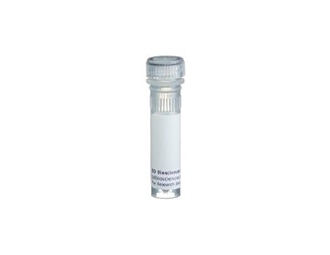Old Browser
Looks like you're visiting us from {countryName}.
Would you like to stay on the current country site or be switched to your country?




Flow cytometric analysis of CD51 on mouse bone marrow myeloid cells. BALB/c bone marrow leukocytes were either left unstained (left panel) or stained with Biotin Rat Anti-Mouse CD51 (Cat. No. 551380, right panel), followed by PE Streptavidin (Cat. No. 554061). Please note that the population of cells having the lowest SSC (erythroid and lymphoid cells) show little expression of CD51, while cells with moderate-to-high SSC (myeloid cells) are almost uniformly CD51 positive (right panel). The contour plots were based on the gated events with the forward and side light-scattering characteristics of viable leukocytes. Flow cytometry was performed on a BD FACScan™


BD Pharmingen™ Biotin Rat Anti-Mouse CD51

Regulatory Status Legend
Any use of products other than the permitted use without the express written authorization of Becton, Dickinson and Company is strictly prohibited.
Preparation And Storage
Recommended Assay Procedures
Flow cytometry: Since this antigen is expressed at low density on the cell surface, it may be desirable to use a second-step reagent conjugated to a "bright" fluorochrome, such as PE Streptavidin (Cat. No. 554061).
Product Notices
- Since applications vary, each investigator should titrate the reagent to obtain optimal results.
- An isotype control should be used at the same concentration as the antibody of interest.
- For fluorochrome spectra and suitable instrument settings, please refer to our Multicolor Flow Cytometry web page at www.bdbiosciences.com/colors.
- Caution: Sodium azide yields highly toxic hydrazoic acid under acidic conditions. Dilute azide compounds in running water before discarding to avoid accumulation of potentially explosive deposits in plumbing.
- Please refer to www.bdbiosciences.com/us/s/resources for technical protocols.
Companion Products



.png?imwidth=320)
The RMV-7 monoclonal antibody specifically binds to CD51, the 140 kDa integrin αV chain. Heterodimers of CD51 with several integrin β chains function as receptors for extracellular matrix proteins. CD51/CD61 (αVβ3 integrin, vitronectin receptor) mediates adhesion to fibronectin, fibrinogen, vitronectin, thrombospondin, von Willebrand factor, and CD31 (PECAM-1). CD51 is expressed on activated T lymphocytes, polymorphonuclear granulocytes, blastocysts, and osteoclasts. CD51 is reportedly not detectable on mouse platelets using either H9.2B8 or RMV-7 antibody clones. CD51 also forms heterodimers with CD29 (integrin β1), integrins β5, β6, and β8 chains. αV integrins have diverse functions in development and homeostasis. The RMV-7 antibody reportedly blocks LAK-cell binding to vitronectin, fibronectin, fibrinogen, and CD31. Furthermore, the RMV-7 antibody reportedly inhibits LAK-cell cytoxicity against certain target cells by interfering with the binding of LAK cells to their target cells.
Development References (8)
-
Bader BL, Rayburn H, Crowley D, Hynes RO. Extensive vasculogenesis, angiogenesis, and organogenesis precede lethality in mice lacking all alpha v integrins. Cell. 1998; 95(4):507-519. (Biology). View Reference
-
Frieser M, Hallmann R, Johansson S, Vestweber D, Goodman SL, Sorokin L. Mouse polymorphonuclear granulocyte binding to extracellular matrix molecules involves beta 1 integrins. Eur J Immunol. 1996; 26(12):3127-3136. (Biology). View Reference
-
Moulder K, Roberts K, Shevach EM, Coligan JE. The mouse vitronectin receptor is a T cell activation antigen. J Exp Med. 1991; 173(2):343-347. (Biology). View Reference
-
Nakamura I, Pilkington MF, Lakkakorpi PT, et al. Role of alpha(v)beta(3) integrin in osteoclast migration and formation of the sealing zone. J Cell Sci. 1999; 112(22):3985-3993. (Biology). View Reference
-
Narumiya S, Abe Y, Kita Y, et al. Pre-B cells adhere to fibronectin via interactions of integrin alpha 5/alpha V with RGDS as well as of integrin alpha 4 with two distinct V region sequences at its different binding sites. Int Immunol. 1994; 6(1):139-147. (Biology: Blocking). View Reference
-
Piali L, Hammel P, Uherek C, et al. CD31/PECAM-1 is a ligand for alpha v beta 3 integrin involved in adhesion of leukocytes to endothelium. J Cell Biol. 1995; 130(2):451-460. (Biology: Blocking). View Reference
-
Schultz JF, Armant DR. Beta 1- and beta 3-class integrins mediate fibronectin binding activity at the surface of developing mouse peri-implantation blastocysts. Regulation by ligand-induced mobilization of stored receptor. J Biol Chem. 1995; 270(19):11522-11531. (Biology). View Reference
-
Takahashi K, Nakamura T, Koyanagi M, et al. A murine very late activation antigen-like extracellular matrix receptor involved in CD2- and lymphocyte function-associated antigen-1-independent killer-target cell interaction. J Immunol. 1990; 145(12):4371-4379. (Immunogen: Blocking, Immunoprecipitation). View Reference
Please refer to Support Documents for Quality Certificates
Global - Refer to manufacturer's instructions for use and related User Manuals and Technical data sheets before using this products as described
Comparisons, where applicable, are made against older BD Technology, manual methods or are general performance claims. Comparisons are not made against non-BD technologies, unless otherwise noted.
For Research Use Only. Not for use in diagnostic or therapeutic procedures.
Refer to manufacturer's instructions for use and related User Manuals and Technical Data Sheets before using this product as described.
Comparisons, where applicable, are made against older BD technology, manual methods or are general performance claims. Comparisons are not made against non-BD technologies, unless otherwise noted.